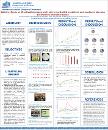Salinity Effects on Symbiodinium sp. growth rate in Controlled conditions and produced Biomass Biochemical Characterization
الملخص
Salinity is an abiotic influencer to the growth and the efficiency of the algal Symbiodinium that coexists in symbiosis with corals. In light of the high salinity conditions that prevail in the Arabian Gulf including the waters of Qatar, we observed the effect of salinity above local-ambient levels on Symbiodinium's growth rate, biomass and its photosynthetic efficiency. Symbiodinium sp. extracted from Platygyra daedalea was launched in f/2 media in controlled incubator conditions at salinities of 30, 40 (control), 45, 50, 60 and 70 psu for 11 days. Subsamples were obtained and fixed for cell density counts and growth rate calculations. Photosynthetic efficiency was determined using an Aquapen, and biomass at the end of the experiment was sent for biochemical characterization. A two-way ANOVA test was performed on the data using SigmaPlot software. Our results indicated that at salinities 55 psu and greater, significant decline in both cell density and photosynthetic efficiency was observed. At 70 psu, growth rate was exclusively negatively affected, and biochemical compositions varied at all salinity levels with a notable increase in lipid content at 70 psu. Impact of high salinity has not been widely studied in the Arabian Gulf. Thus, this study will aid conservational efforts while also encouraging further studies on the contribution of abiotic factors to Symbiodinium sp. growth in the region.
معرّف المصادر الموحد
https://doi.org/10.29117/quarfe.2021.0072DOI/handle
http://hdl.handle.net/10576/24339المجموعات
- العلوم البيولوجية والبيئية [936 items ]
- Theme 1: Energy and Environment [73 items ]


